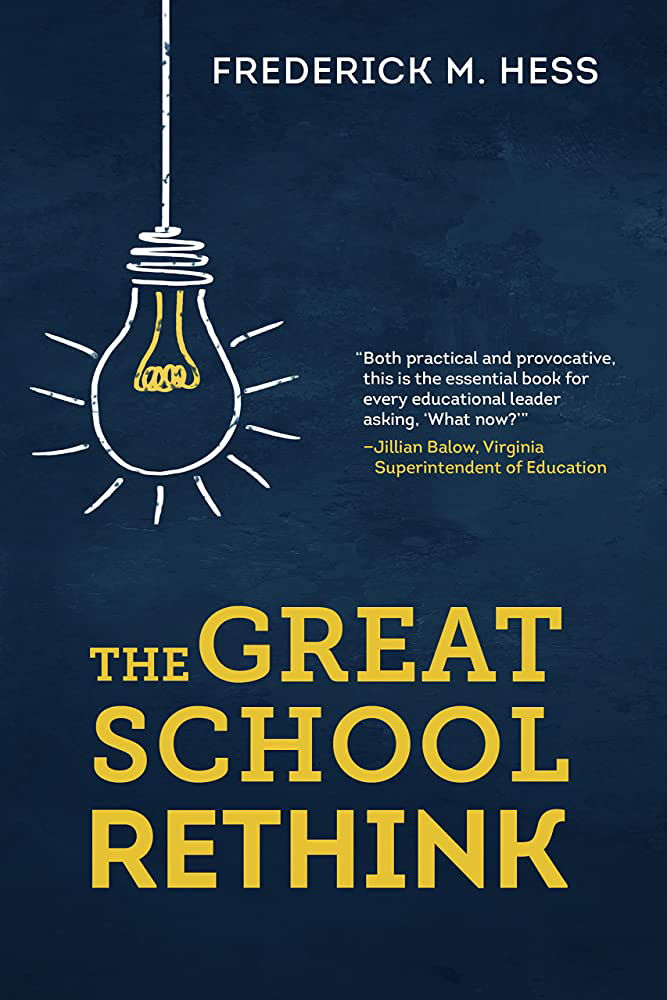
Discussions of school choice frequently fall into familiar morality plays: Either you’re for empowering parents or supporting public education. The resulting debate manages to miss much of what matters. It ignores that all kinds of choices are hard-wired into American public education. It skips past the fact that the affluent already choose schools when purchasing homes, so the debate is really about the options available to everyone else.
Families want more options, but that fact doesn’t mean they dislike their local schools (much less, that they’re eager to flee them). In 2022, for instance, more than three-quarters of parents said that they were satisfied with their child’s experience in a public district school even as more than seven in ten endorsed education savings accounts, school vouchers, and charter schools. In short, parents overwhelmingly like both their child’s public school and school choice policies. They don’t see a tension here.
How can that be? How do we reconcile parent support for more choices with affection for their local public schools? It’s not hard, really. Parents want alternatives when it comes to scheduling, school safety, or instructional approach. They want to be able to protect their kids from bullies or from school practices they find troubling. At the same time, though, they also value schools as community anchors, they like their kid’s teachers, and they may live where they do precisely because they like the local schools.
Families can embrace options without wanting to abandon their local public schools. The notion that one is either for empowering parents or supporting public education is a misleading one. Real parents don’t think this way.
So, how does a Rethinker approach the school choice debate? It helps to start not with sweeping ideological claims but by asking how expanding options might work for students, meet the needs of families, and empower educators.
Choice Is Woven Into the Fabric of American Schooling
Amidst today’s partisan sniping, it can be easy to forget that educational choice has been woven into the fabric of American education from the nation’s earliest days. During the colonial era, it was presumed that most children would get only a rudimentary education and that only a tiny handful of affluent white families would choose to have their sons pursue more formal education (often to prepare for the ministry). Schools were routinely located in churches, and local church leaders were charged with choosing the schoolteacher. In that era, the notion that there was any tension between parental choice, the role of religion, and public provision would’ve been deemed an odd one!
In recent decades, as charter schools have grown to enroll more than 3 million students, the tapestry of options has grown to increasingly include scholarship (or voucher) programs, education savings accounts, microschools and learning pods, course choice options, hybrid homeschooling, and more.
Thinking More Expansively About Choice
Choice isn’t only an integral part of the American education landscape—it’s embedded in public schools themselves. From start to finish, schooling is a stew of choices made by parents, students, educators, system officials, and policymakers. Parents choose whether to send their children to pre-K, when to start kindergarten, or whether to opt their child out of sex education. Students choose groups and activities, which electives to take, and what book to read for a book report. Teachers choose where to apply for a job, which materials they use, and how to deliver instruction. District staff choose policies governing discipline, curricula, field trips, and attendance zones.
Outside of school, we take for granted that families will choose childcare providers, pediatricians, dentists, babysitters, and summer programs. Indeed, many such choices involve parents or guardians making decisions that are subsidized by government funds. And the choices they make will have big implications for a child’s health, well-being, upbringing, and education.
The same options that appeal to families can empower teachers and school leaders who feel stuck in unresponsive schools or systems. Educators, like parents, can value public education while wanting more opportunities to find or create learning environments where they’ll be free from entrenched rules, regulations, contract provisions, and customs.
The Lessons of Learning Pods
 Learning pods offer one intriguing way to rethink the boundary between schooling, tutoring, and study groups. A learning pod is a handful of students who study together, under the auspices of a tutor, outside of a traditional school setting (mostly to augment school-based instruction rather than replace it). Learning pods leapt into the public eye during the pandemic, as families caught up in remote learning sought to provide their kids an organized, intimate, and supportive environment.
Learning pods offer one intriguing way to rethink the boundary between schooling, tutoring, and study groups. A learning pod is a handful of students who study together, under the auspices of a tutor, outside of a traditional school setting (mostly to augment school-based instruction rather than replace it). Learning pods leapt into the public eye during the pandemic, as families caught up in remote learning sought to provide their kids an organized, intimate, and supportive environment.
Now, learning pods might be an artifact of Covid-19 and easy to see as a bit of a “that-was-then” time capsule. Fair enough. Even if that ultimately proves to be the case, though, there are some terrific takeaways here.
The tens of thousands of learning pods that emerged across the country were most commonly described as something akin to sustained, high-intensity tutoring. Kids got customized attention in a comfortable, face-to-face environment. While learning pods may have been largely a makeshift response, more than half of families and three-quarters of instructors said they preferred their pod experiences to prior experiences in school.
Researchers studying learning pods found that, by 3-to-1, parents said that their kids felt more “known, heard, and valued” than they had in school and that, by 2-to-1, children were more engaged in their learning. Contrasting the intimate pod experience with the “anonymity” of school, one parent explained, “There’s no getting lost in this. In the pod, there’s no sneaking by without getting your work done like there would be in school.”
So, are pods a good idea? It depends. It depends on what they’re used for and how they’re constructed. But it’s not hard to imagine them providing more intensive support or an alternative learning environment for students who are struggling in a conventional classroom. School systems could help interested parents find one another, connect with local resources, and locate a qualified instructor; such aid could be especially valuable for low-income or non-English speaking families, who might find the option appealing but struggle to organize or finance learning pods on their own.
Microschools and Charter Teachers
Microschools are really small schools which provide the occasion to radically rethink the teacher’s role and the contours of the schoolhouse. Microschools typically have a few dozen students (or even fewer), who usually attend in person. The schools employ one (or a handful) of teachers to lead instruction. Unlike most learning pods, microschools aren’t supplemental programs; they are a child’s school.
For students lost amidst the oft-impersonal rhythms of institutional life, the intimate scale can be reassuring. This kind of environment may be a better fit for students who struggle with discipline or behavior in a conventional classroom. It also can allow for more personalization, parent-teacher collaboration, or advanced learning than the standard schoolhouse allows.
At the same time, microschools pose a host of challenges. How do they handle infrastructure? Teacher absences? Coverage of a full curriculum? What would it look like for school or system leaders to have the ability to arrange for internal microschools? The answers are very much a work in progress.
One particular version of microschooling is the “charter teacher” model, which would enable teachers to get state-granted authorization to operate autonomous classrooms within traditional district schools. Charter teachers would have wide latitude to hire assistants, choose how many students to instruct, decide how many classes they’d teach, and determine their own instructional model. Teachers would agree to be held accountable for student outcomes and only teach students whose parents choose to enroll their child with that teacher.
For a sense of how this might work, consider the pediatric model. Pediatricians typically work in partnerships, have a significant say when it comes to scheduling and hiring support staff, and choose how many patients to serve. At the same time, of course, patients are free to choose their pediatric practice and their pediatrician. (In one sense, the “charter teacher” approach simply democratizes access to the “choose-your-teacher” machinations regularly employed by connected parents who know how to pressure principals and work the system). Teachers disenchanted by large bureaucracies would have new freedom, while more flexible or part-time options could draw former educators back into the profession.
The charter teacher model isn’t currently in use. Putting it into practice would require state officials to establish a process by which teachers could demonstrate professional mastery or a record of high student achievement. Qualified teachers could obtain small grants to launch their own practices, after which they’d be funded on a per pupil basis developed by the school district.
Hybrid Homeschooling
It may be hard to fathom today but, a half-century ago, homeschooling was illegal across most of the U.S. A series of legal and political battles in the 1970s and 1980s changed that. By 2020, more than three million children a year were being homeschooled, a number that increased dramatically during the Covid-19 pandemic. But just what does it mean to “homeschool” a child?
While the term “homeschooling” may bring to mind a picture of a parent and a child sitting at a kitchen table, the reality is that most homeschool families make extensive use of networks, online resources, tutors, and much else. Indeed, the difference between homeschooling and a learning pod (or a microschool) is often just a matter of degree.
In the wake of the pandemic, there was broad interest in education options that incorporate more of what homeschooling provides. In 2022, two-thirds of parents with children in special education said they’d like a school schedule which had their child learning at home at least one day a week (though just 15 percent of parents wanted to do full-time homeschooling). Among other parents, more than half said they’d like to have their child home at least one day a week. Oh, and just over half of teens said they’d like to learn at home at least one day a week.
In other words, lots of parents and students are interested in maintaining some of the parent-child interaction they experienced during the pandemic but don’t want to be “homeschoolers.” Hybrid homeschooling seeks to provide what those families are seeking, with students enrolling in school for part of the week and learning from home for the other part. More than 1,000 hybrid homeschools have emerged across the country in recent years. Many are private schools, others are charter schools, and a handful are part of traditional school districts.
Arrangements can play out in many ways. A hybrid homeschool might have students in the building four days a week, with different classes (or grades) of students learning from home on different days. It might have all students learning at home on Mondays or Wednesdays or on certain mornings or afternoons. Some schools are more prescriptive when it comes to curricula, while others leave more to parent discretion. For younger children, parents generally play a much larger instructional role, while there’s more independent study for older children.
The feasibility of such arrangements depends on the laws of a given state, but school and system leaders may find state policies and federal regulations more accommodating than they’d have thought. In Idaho, for instance, if homeschool students use district programming on even a part-time basis, they’re included in district attendance counts for state funding. This has, not surprisingly, made it easier for districts to support homeschool families. And Idaho is far from alone—at least a dozen states have similar arrangements, although the rules vary with regards to services, student eligibility, and how funding works.
The Possibilities of Course Choice
Another approach to educational choice is course choice. Course choice is a way to move new options into a student’s current school rather than to move a student to a new school.
While some families want to switch schools, I noted a bit earlier that more than 70 percent of parents consistently say they’re satisfied with their child’s school. Of course, this doesn’t mean those parents like everything about their school. Families may want students to stay with friends, familiar teachers, and established routines but also have access to alternative courses. Overall satisfaction with a school doesn’t necessarily reflect satisfaction with the arts program, math curriculum, reading instruction, Advanced Placement offerings, or what-have-you. Even pre-pandemic, parents who liked their school might have still grumbled about these things. Now, with so many students forcibly acclimated to a variety of remote learning options and providers, it seems only sensible that students should be able to take advantage of such options without changing schools.
The notion of “course choice” allows students to tap into instructional options that aren’t available at a student’s school. Course choice gives students the ability to take courses beyond those offered by their local school district. These courses may be offered by neighboring districts, state higher education institutions, virtual learning providers, or specialized tutoring services. Course choice laws typically specify that a portion of the student’s per pupil outlay can be used to pay the costs of enrollment.
Students may be able to access courses in chemistry, constitutional law, or AP calculus even if their school lacks a chemistry teacher, a constitutional law class, or an AP math program. This can be a solution for small schools dealing with staffing constraints, struggling to attract teachers in certain subjects or fields, or where only a tiny number of students want to enroll in a given class.
Course choice programs can come in many flavors. New Hampshire’s “Learn Everywhere” program allows high school students to earn a “certificate of credit” from any program recognized by the state board of education which can demonstrate that students have met the learning objectives.
Course choice allows students in a high school with a short-staffed science department to still study advanced physics. And it can make it possible for students to study robotics or Russian, even if their school lacks the requisite staff. If this all sounds pretty far removed from our heated debates about school choice, you’ve got the idea.

What about Bad Choices?
Parents may make bad choices, just as with day care or dentists. But we also reasonably presume that parents will make better choices when they have better information. So, how can we supply the kind of information that can help parents make good choices?
State tests and other academic assessments are one useful, consistent gauge. While such data is necessary, few parents or teachers think it’s sufficient. Thus, it’s crucial to consider other ways to ensure quality. There is an array of potential tools, including:
- Professional, systematic ratings of customer satisfaction, something akin to the information reported by sources like J.D. Powers and Associates. These make it easy for consumers to draw on the judgments of other users.
- Scientific evaluations by credible third parties, such as those offered by Consumer Reports. Such objective evaluations allow experts to put new educational offerings through their paces and then score them on relevant dimensions of performance, as well as price.
- Expert evaluation of services like those provided by health inspectors (or, in schooling, the famous example of the British School Inspectorate). Such evaluation focuses on examining processes and hard-to-measure outcomes, drawing on informed, subjective judgment.
- Reports reflecting user experiences—essentially, drawing on the wisdom of crowds. Online providers routinely allow users to offer detailed accounts of the good and bad they’ve experienced, and the public to readily view what they have to say. While these results aren’t systematic or scientific, they are very good at providing context and color.
Of course, even with terrific information, parents can still make bad choices about schooling. But that’s true of pretty much anyone involved in schools: Teachers can make bad choices when deciding how to support a struggling student or design an individualized education program. Administrators can make bad choices when assigning a student to a school or teacher.
Schooling is suffused with choices. We should certainly ask what happens when a parent makes a poor choice. But we must also question the consequences of restrictive policies which limit parents’ ability to find better educational options for their kids.
Rethinking School Choice
It’s odd that the discussion of school choice has so often taken the shape of heated argument, given the intuitive appeal of the idea that all parents (rich and poor alike) should have a say in their kids’ schooling.
Our familiar fights are both distracting and odd. Consider that in a field like healthcare, even those most passionate about universal, publicly funded coverage still believe that individuals should be free to choose their own doctor. In housing, even the most ardent champion of public housing thinks families should get to choose where they live. There’s no debate about whether families should have agency when it comes to such high-stakes decisions in health care or housing. The same logic should apply in schooling. It’s not selfish or risky for parents to want a say in who teaches their kids or where their kids go to school. It’s normal.
It’s downright weird that educational choice has focused so narrowly on students changing schools. After all, we live in an era when extraordinary options have become routinely available.
In the end, the real promise of choice isn’t just that it can help students escape struggling schools. It’s that it can help make room for parents and educators alike to rethink how they want schools to work.
Adapted with permission from Hess, F. M. (2023). The Great School Rethink. Harvard Education Press.


